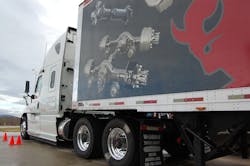An exhaustive review of 10 different data sets in a new report issued by the North American Council for Freight Efficiency (NACFE) this week finds that a 6x2 axle configuration can on average improve Class 8 sleeper tractor fuel economy by 2.5% versus a traditional 6x4 setup, with a 20 month payback period required to offset the higher initial cost of the 6x2 package.
“We have medium to high confidence in these findings due to all the testing,” Mike Roeth, NACFE’s executive director, explained to Fleet Owner in an interview. “That’s in part because none of the 10 sets of data we examined have been published to our knowledge.”
[A video-based overview of NACFE’s report is provided below.]
Roeth noted that “data sets” included: two 6x2 axle truck tests conducted by axle builders; two conducted by truck OEMs; five fleets test; and three by NACFE using Society of Automotive Engineer (SAE) fuel economy test parameters.
“It’s very hard to test trucks because so many different variables are involved: weather, geography, temperature, load weight, etc.,” he pointed out. “That’s one reason why we believe the more data sets we can obtain about a particular technology, the better the analysis we can conduct. A lot of fleets test products but keep the results to themselves. We want to try and get more of them to share that in a non-competitive environment.”
[Below is a video review of some of the 6x2 testing conducted by NACFE.]
For example, Roeth noted that NACFE’s research indicated that 6x2 axle packages cost on average $1,000 to $2,000 more than the 6x4 variant largely due to their small production volumes as only 2.3% of all new Class 8 sleeper trucks built in 2013 came equipped in 6x2 configuration.
“So if the confidence in the technology can be increased and more 6x2 configurations sold, that will drive down the price and improve resale values,” he explained. “That in turn helps those fleets already investing in 6x2 packages; thus they benefit from sharing their test data.”
NACFE’s goal is also to provide a “warts-and-all” view of potential fuel saving technologies, so fleets get a more straightforward look at potential trade-offs.
“In the case of 6x2s, there are several,” Roeth said. “Weight is lowered by 400 lbs. on average compared to a 6x4 but purchase price on the 6x2 is as noted before $1,000 to $2,000 higher. There is less mechanical maintenance needed on 6x2s compared to 6x4s but higher electronics service is need. That is because electronic load shifting technology helps mitigate traction losses in 6x2 configurations and we recommend that be spec'd for the 6x2 package.”
Indeed, the potential loss of traction is the number one issue turning fleets off from 6x2 axle packages despite the fuel savings potential, he pointed out.
“But we’ve found in our study that electronic load shifting systems, and even manual air-dump valves, can mitigate much of that traction issue,” Roeth said. "The science says you cannot equal 6x4 traction with a 6x2 package but you can get pretty close with load-shifting systems.”
Finally, NACFE found that tire wear is much higher in 6x2 configurations versus 6x4 setups, on average resulting in $466 more in tire wear costs per year.
“We will always address challenges and drawbacks of particular fuel-saving technologies in our reports,” Roeth stressed. “We need to provide fleets with a complete picture. But the more test data we can get about particular products, the more confidence we can provide to the industry in temrs of the fuel saving results.
About the Author
Sean Kilcarr
Editor in Chief
Sean Kilcarr is a former longtime FleetOwner senior editor who wrote for the publication from 2000 to 2018. He served as editor-in-chief from 2017 to 2018.
